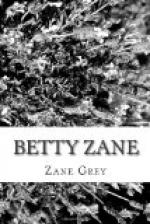The Hurons had sided with the French in Pontiac’s war, and in the Revolution they aided the British. They allied themselves with the Mingoes, Delawares and Shawnees and made a fierce war on the Virginian pioneers. Some powerful influence must have engendered this implacable hatred in these tribes, particularly in the Mingo and the Wyandot.
The war between the Indians and the settlers along the Pennsylvania and West Virginia borders was known as “Dunmore’s War.” The Hurons, Mingoes, and Delawares living in the “hunter’s paradise” west of the Ohio River, seeing their land sold by the Iroquois and the occupation of their possessions by a daring band of white men naturally were filled with fierce anger and hate. But remembering the past bloody war and British punishment they slowly moved backward toward the setting sun and kept the peace. In 1774 a canoe filled with friendly Wyandots was attacked by white men below Yellow Creek and the Indians were killed. Later the same year a party of men under Colonel Cresop made an unprovoked and dastardly massacre of the family and relatives of Logan. This attack reflected the deepest dishonor upon all the white men concerned, and was the principal cause of the long and bloody war which followed. The settlers on the border sent messengers to Governor Dunmore at Williamsburg for immediate relief parties. Knowing well that the Indians would not allow this massacre to go unavenged the frontiersmen erected forts and blockhouses.
Logan, the famous Mingo chief, had been a noted friend of the white men. After the murder of his people he made ceaseless war upon them. He incited the wrath of the Hurons and the Delawares. He went on the warpath, and when his lust for vengeance had been satisfied he sent the following remarkable address to Lord Dunmore:
“I appeal to any white man to say if ever he entered Logan’s cabin and he gave him not meat: if ever he came cold and naked and he clothed him not. During the course of the last long and bloody war Logan remained idle in his cabin, an advocate of peace. Such was my love for the whites that my countrymen pointed as they passed and said: ‘Logan is the friend of the white man.’ I had even thought to have lived with you but for the injuries of one man, Colonel Cresop, who, last spring, in cold blood and unprovoked, murdered all the relatives of Logan, not even sparing my women and children. There runs not a drop of my blood in the veins of any living creature. This called upon me for vengeance. I have sought it: I have killed many; I have glutted my vengeance. For my country I will rejoice at the beams of peace. But do not harbor a thought that mine is the joy of fear. Logan never felt fear; he could not turn upon his heel to save his life. Who is there to mourn for Logan? Not one.”
The war between the Indians and the pioneers was waged for years. The settlers pushed farther and farther into the wilderness. The Indians, who at first sought only to save their farms and their stock, now fought for revenge. That is why every ambitious pioneer who went out upon those borders carried his life in his hands; why there was always the danger of being shot or tomahawked from behind every tree; why wife and children were constantly in fear of the terrible enemy.




